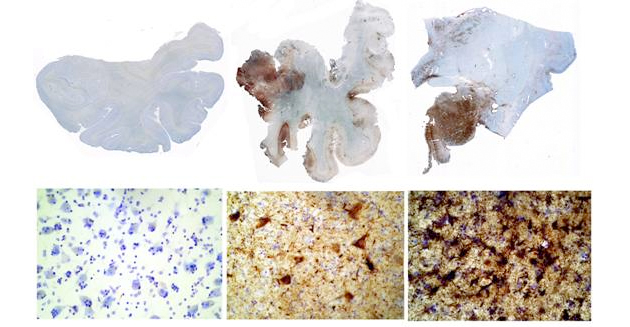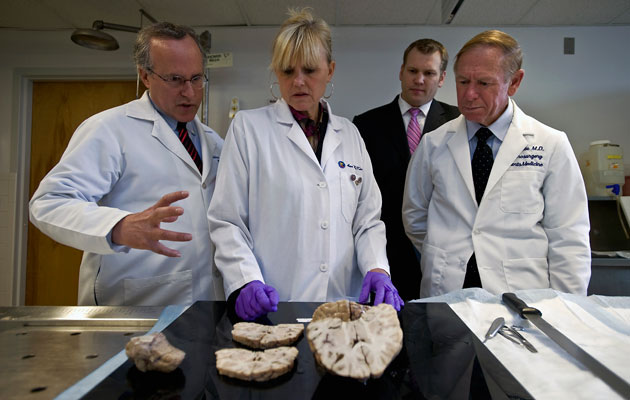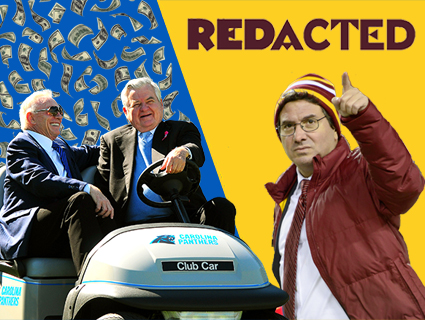
Brain tissue images, with tau protein in brown. The brain on the left is from a normal subject, the brain in the middle is from a former football player, and the brain on the right is from a former boxer.Courtesy of the <a href="http://www.bu.edu/cste/about/what-is-cte/">Boston University Center for the Study of Traumatic Encephalopathy</a>.
League of Denial, a PBS Frontline documentary about the NFL’s response (or lack thereof) to concussions and long-term brain injuries among its players, airs tonight. The investigation attempts to hash out what the league really knew about player safety while it downplayed the ill effects the sport has on its athletes. But what exactly are those effects, and what about them made thousands of former players sue the NFL over their injuries?
While the symptoms of a concussion—dizziness, vomiting, memory loss—can be felt immediately, the long-term impacts of repeated brain trauma have been harder to study. Research points to chronic traumatic encephalopathy, or CTE, as one of the major outcomes. CTE is caused by a buildup of tau, a protein that strangles brain cells and degenerates brain tissue, which is caused by repetitive brain trauma like the hits football players endure. This leads to depression, increased aggression, lack of impulse control, and eventually dementia, which may not manifest until years or even decades after the brain injuries took place. While CTE can only be definitively identified after a patient dies, a pilot study at the University of California-Los Angeles earlier this year found evidence of tau in five living former NFL players.
Evidence of CTE was found in former linebacker Junior Seau, who committed suicide last year. Seau’s son and ex-wife said he had become prone to uncharacteristic mood swings, forgetfulness, and depression. Two other former players—Dave Duerson and Ray Easterling—were also found to have CTE after committing suicide. The condition is not limited to retired players (Cincinatti Bengals receiver Chris Henry was the first active NFL player to have died with trauma-induced brain damage) or even to professionals (the disease was also found in a 21-year-old University of Pennsylvania lineman who committed suicide in 2010).
Repeated brain injuries are also linked to post-traumatic stress disorder and diseases like Parkinson’s and Alzheimer’s. A 2009 study commissioned by the NFL found that former NFL players had been diagnosed with Alzheimer’s disease or other memory problems 19 times more than the normal rate for men between the ages of 30 and 49. The NFL went on to back away from those findings, though, even as it changed game rules to avoid more dangerous hits and donated money for more brain injury research.
These revelations led to a lawsuit against the NFL that eventually counted more than 4,500 former players among its plaintiffs. In August, the league reached a settlement, agreeing to pay $765 million to fund medical exams, concussion-related compensation, medical research for retired NFL players and their families, and litigation expenses. The lawsuit never reached the discovery phase, meaning the NFL never had to reveal what it did or didn’t know about concussions and long-term health effects on players. According to Steve Fainaru and Mark Fainaru-Wada’s upcoming book, also titled League of Denial, NFL officials cherry-picked sponsored research, pushed influential medical journal Neurosurgery to publish its work, and antagonized independent researchers who spoke with reporters about the link between football and CTE.
Hundreds of millions of dollars won’t make football-related brain injuries—or the NFL’s PR headache—go away. Four more former players sued the league and helmet maker Riddell for allegedly hiding information about the dangers of playing. Increased pressure like that, combined with the Fainaru brothers’ book and the Frontline documentary, could lead to bigger changes in the NFL, which would likely trickle down to the college, high school, and even Pee Wee levels. The way Americans view their favorite sport is changing, but it remains to be seen whether the sport will change to match.














